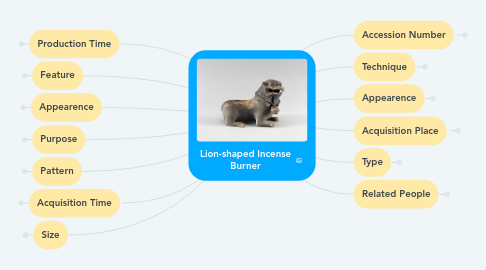
1. Production Time
1.1. Yuan Dynasty
1.1.1. The Yuan Dynasty is a Mongolian kingdom that dominated almost all of East Asia, centering on mainland China, between the mid-13th century and the mid-14th century.
1.1.1.1. Other relics made during the Yuan Dynasty
1.1.1.1.1. Garlic-shaped bottle
1.1.1.1.2. Black dot-patterned jar
1.1.1.1.3. Water buffalo-shaped yeonjeok
1.1.1.1.4. Lotus&fish-patterned wan
1.1.1.1.5. Dragon-pattern Prunus Vase
1.1.1.1.6. Kettle
1.1.1.1.7. Celadon large vase with applique chrysanthemum design
2. Feature
2.1. A lion has a bell on its neck.
3. Appearence
3.1. This incense burner is a shape of Sanye sitting with four legs on the ground, with wide-opened eyes and mouth to make sure that the scent of incense can spreads through its mouth. A large bell is rounded on the neck of Sanye also. Sanye's tail is parallel to the left dunbu
3.1.1. A large bell is rounded on the neck
3.1.2. Dunbu
3.1.2.1. Dunbu means the upper part of the pottery’s hip.
4. Purpose
4.1. Incense burner
4.1.1. An incense burner is a small furnace that burns incense. There are various ingredients and shapes to make, and they are divided into daily use and ritual use.
5. Pattern
5.1. None
6. Acquisition Time
6.1. This pottery was discovered in 1980.
6.1.1. 같은 시기에 입수된 다른 유물
6.1.1.1. Garlic-shaped bottle
7. Size
7.1. L. 13.3cm
8. Accession Number
8.1. Sinan 6639
9. Technique
9.1. intaglio line
9.1.1. An intaglio line means a line in intaglio. The intaglio is a technique in which the pattern on the surface of the artifact is concavely cut with a carving knife, and the pattern itself is dug and the floor protrudes. Patterns are drawn on the surface, the inside of the pattern is carved and sometimes expressed as a line. Along with embossing, it is one of the widely used sculpting techniques.
10. Related People
10.1. Hong Chu
10.1.1. Hong Chu is a literary man of the Northern Song Dynasty, and in his work 『Hyangbo』, he described historical materials, usage, and combination of various scents.
10.1.1.1. Hong Chu's work.
10.1.1.1.1. 『Hyangbo』 is a book compiled by Hong Chu of Northern Song. It has historical records, usage methods, and combination methods of various scents and methods. 『Hyangbo』 was the first to create an item for the usage of incense, and it was classified and explained by the quality, distinction, consciousness, and custom of incense.
10.1.1.2. The country where Hong Chu was born.
10.1.1.2.1. Northern Song
11. Appearence
11.1. Sanye
11.1.1. Sanye means a lion dance while wearing a lion's mask and swinging its tail while shaking its head.
11.2. Qilin
11.2.1. Qilin means an imaginary animal that is said to appear as a sign of an adult appearing in this world. The body is like a deer, the tail is like a cow, the hooves and mane are like horses, and the color is five colors.
11.3. Mandarin ducks
11.3.1. Mandarin ducks are birds of the wild goose family and are designated as Natural Monument No. 327 in Korea. Although it is a natural monument, it is easy to see in lakes and rivers due to its large population due to its compliance with environmental adaptability.
11.4. Duck
11.4.1. Duck refers to both ducks and birds. There is a web between the toes, and the beak is flat. Types include black ducks, mallards, and white-cheeked black ducks.
12. Type
12.1. Metal pottery
12.1.1. How to call these animals.
12.1.1.1. Garlic-shaped bottle
12.1.1.2. Lion-shaped incense burner
12.1.1.2.1. How to call these animals
12.1.1.3. Kettle
13. Acquisition Place
13.1. This relic was found in Sinan.
13.1.1. Different artifacts were obtained from the same place.
13.1.1.1. Garlic-shaped bottle
13.1.1.2. Crane-pattern pillow
13.1.1.3. Black dot-patterned jar
13.1.1.4. Water buffalo-shaped yeonjeok
13.1.1.5. Lotus&fish-patterned wan
13.1.1.6. Dragon-pattern Prunus Vase
13.1.1.7. Kettle
13.1.1.8. Celadon large vase with applique chrysanthemum design
13.1.1.9. Dark-glazed wan
13.2. Sinan shipwreck
13.2.1. Sinan shipwreck became known in 1975 when a fisherman caught six pottery in a net while fishing. The fisherman reported the pottery to the Sinan-gun office in January of the following year, and excavation began in October of that year. In the sea, a large number of artifacts for foreign trade, including celadon made during the Yuan Dynasty, were excavated.
